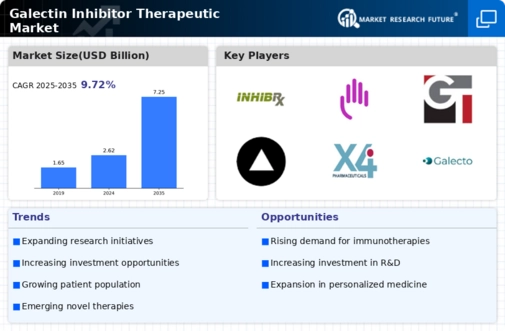Advancements in Drug Development
Recent advancements in drug development technologies are likely to propel the Galectin Inhibitor Therapeutic Market forward. Innovations in high-throughput screening and molecular modeling have enhanced the ability to identify and optimize galectin inhibitors. These technological improvements facilitate the discovery of novel compounds that can effectively target galectins, which may lead to breakthroughs in treatment options. Furthermore, the integration of artificial intelligence in drug discovery processes is expected to streamline the development pipeline, potentially reducing time-to-market for new therapies. As a result, the market may witness an influx of new entrants and products, thereby increasing competition and driving further research and investment.
Regulatory Support for Novel Therapies
Regulatory bodies are increasingly supportive of novel therapeutic approaches, which appears to benefit the Galectin Inhibitor Therapeutic Market. Initiatives aimed at expediting the approval process for innovative treatments are becoming more common, allowing for faster access to potentially life-saving therapies. The introduction of programs such as breakthrough therapy designations and orphan drug status has encouraged pharmaceutical companies to invest in the development of galectin inhibitors. This regulatory environment may lead to a more favorable market landscape, as companies are incentivized to bring their products to market more swiftly, thereby addressing unmet medical needs in various disease areas.
Rising Awareness of Galectin Functions
There is a growing awareness of the roles that galectins play in various biological processes, which seems to be driving interest in the Galectin Inhibitor Therapeutic Market. As research elucidates the involvement of galectins in inflammation, fibrosis, and tumor progression, the potential for targeted therapies becomes increasingly apparent. Educational initiatives and scientific publications are contributing to this heightened awareness, fostering collaboration among researchers and clinicians. This trend may lead to increased funding for galectin-related research and the development of targeted therapies, ultimately expanding the market for galectin inhibitors. The recognition of galectins as therapeutic targets could significantly influence treatment paradigms across multiple disease states.
Growing Investment in Biopharmaceuticals
The surge in investment within the biopharmaceutical sector is a notable driver for the Galectin Inhibitor Therapeutic Market. Venture capital and private equity funding have increasingly targeted biopharmaceutical companies focusing on innovative therapies, including galectin inhibitors. This influx of capital is likely to accelerate research and development efforts, enabling companies to advance their product pipelines. According to recent data, investments in biopharmaceuticals have reached unprecedented levels, with billions allocated to research initiatives. This financial support not only fosters innovation but also enhances collaboration between academia and industry, potentially leading to the discovery of new therapeutic applications for galectin inhibitors.
Increasing Prevalence of Chronic Diseases
The rising incidence of chronic diseases such as cancer, diabetes, and autoimmune disorders appears to be a primary driver for the Galectin Inhibitor Therapeutic Market. As these conditions become more prevalent, the demand for innovative therapeutic solutions intensifies. Research indicates that galectins play a crucial role in the progression of these diseases, suggesting that targeting them could yield effective treatments. The market for galectin inhibitors is projected to grow significantly, with estimates indicating a compound annual growth rate of over 15% in the coming years. This growth is likely fueled by the increasing recognition of galectin inhibitors as potential therapeutic agents, thereby expanding the market landscape.


















Leave a Comment